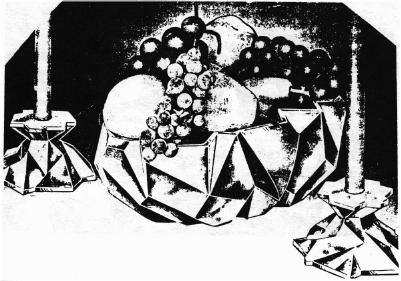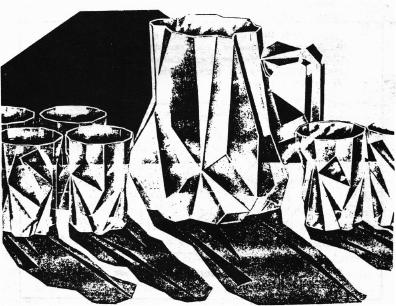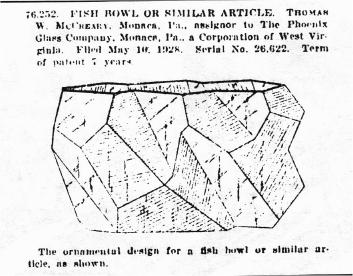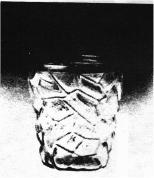National Depression Glass Association
Preserving America's Glass Manufacturing Heritage
Ruba Rombic
by William Heacock
Glass Review - February 1986
The story from Kenneth Haley is that this line was named by his
mother, who might have been concocting a derivative of her nickname for
her husband, "Roamin' Reuben" (he liked to travel all over the
 country). However, the official company explanation of the odd name is
given in the 1928 ad reprinted in Weatherman's Depression Glass
2, p. 48. It is a rather liberal interpretation of the Arabic word
"Rubaiy" (or "Rubaiyah") meaning "poem or epic" and "Rombic" (properly
"Rhombic") meaning "irregular in shape". The line was introduced that
year and you may be interested in reading this trade journal review of
RUBA ROMBIC:
country). However, the official company explanation of the odd name is
given in the 1928 ad reprinted in Weatherman's Depression Glass
2, p. 48. It is a rather liberal interpretation of the Arabic word
"Rubaiy" (or "Rubaiyah") meaning "poem or epic" and "Rombic" (properly
"Rhombic") meaning "irregular in shape". The line was introduced that
year and you may be interested in reading this trade journal review of
RUBA ROMBIC:
"... this year (Consolidated) has certainly outdone itself with its new "Ruba Rombic," which it is pleased to call 'an epic in modern art.' This is an absolutely cubist creation, and some would call it the craziest thing ever brought out in glassware. The shapes, even to the tumblers, are all twisted and distorted, though at that geometrically correct. The first reaction on viewing it is all but shock, yet the more the pieces are studied the more they appeal and there comes a realization that with all their distorted appearance they have a balance that is perfect and are true specimens of cubist art. In the line are tumblers, whiskey flasks, vases in wide variety, bowls, and, indeed, a complete range of fancy pieces, all of which, by the way, are done in satin finish. Special colors have been created for the line. One of these is known as the 'Smoky Topaz,' another is the 'Silver Gray.' In addition to these, there are lilac, honey and jade."
 The above quote tells us much of what we need to know about this
line, which is highly popular with collectors of Art Deco today. This
is perhaps one of the most expensive patterns to collect from the
Depression era. A simple plate can bring as much as $50 to $100. The
line is particularly expensive in the cased green and in silver-deposit
decoration.
The above quote tells us much of what we need to know about this
line, which is highly popular with collectors of Art Deco today. This
is perhaps one of the most expensive patterns to collect from the
Depression era. A simple plate can bring as much as $50 to $100. The
line is particularly expensive in the cased green and in silver-deposit
decoration.
The colors available in RUBA ROMBIC are a study in themselves. The catalogue on file at Corning Museum of Glass includes price lists on the pattern, including the colors of "Silver Cloud" and "Jungle Green". The "honey" color listed in the trade journals is extremely rare. Ken Haley still owns a single piece of this color, revealing it to be an unusual golden amber blending through several shades into a yellow. It is NOT the same as the "honey" made in CATALONIAN, which is a fired on color. The "Smokey Topaz" listed by the trade journal is a golden amber cased with a thin white interior. "Silver Cloud" appears to be the cased white with crystal, "Silver Grey" is a smokey color, and Jungle Green is a deep emerald green. Weatherman's Price Trends 2, p. 53 lists three shades of green, one of them a "dark green". I recall seeing a RUBA ROMBIC piece in an unlisted black, but never picked it up to see if the base color was an intense shade of amethyst, cobalt or green.
RUBA ROMBIC was copied by Phoenix, who must have been jealous of the
attention given the design. A large "fish bowl or similar article" (shown below, left) was
designed by T.W. McCreary, who filed for a patent on May 10, 1928 -
AFTER the original RUBA ROMBIC's introduction to the market. The patent
was assigned to Phoenix. This bowl is found today with patent markings
 and the initials of Phoenix Glass Co. underneath. It is very rare, and
is known in a true vaseline color, unlike the Smoky Topaz made at
Consolidated, which is cased.
and the initials of Phoenix Glass Co. underneath. It is very rare, and
is known in a true vaseline color, unlike the Smoky Topaz made at
Consolidated, which is cased.
There are other copies and look-alikes which appeared on the market around this time. A similar cubist-style design was made by Kopp Glass, Inc. at Swissvale, Pa., also in 1928. Nicholas Kopp was a close friend and former associate of James Lewis.
 Thus, 1928 seems to have been a big year for "cubist" designs.
Westmoreland made a line with very similar styling which
Weatherman's Depression Glass 2, p. 369 calls ROCKER (photo at right).
Thus, 1928 seems to have been a big year for "cubist" designs.
Westmoreland made a line with very similar styling which
Weatherman's Depression Glass 2, p. 369 calls ROCKER (photo at right).
Weatherman dates the catalogue in which ROCKER appears from 1924, but there are strong indications that the catalogue may date much later. Two "pickle jar vases", one of them described as "very new" in a 1927 trade journal notice (Weatherman's Depression Glass 2, p. 359), are clearly pictured in the catalogue reprint. The line called BRAMBLE (Weatherman's Depression Glass 2, p. 379) in this same Westmoreland reprint is strangely similar in style to Consolidated's MARTELE tableware (Weatherman's Price Trends 2, pp. 49-50) which was introduced in 1927. The Weatherman reprint probably dates after the introduction of MARTELE (1926) and RUBA ROMBIC (1928), as both lines were clearly described as innovative and new in trade journals. The year 1930 or later is a more likely date for the Westmoreland catalog, especially since CAMEO DIAMOND (Weatherman's Depression Glass 2, p. 3641 is described as "introduced in 1930" and it too is shown in the reprint in Weatherman's Depression Glass 2, p. 372.